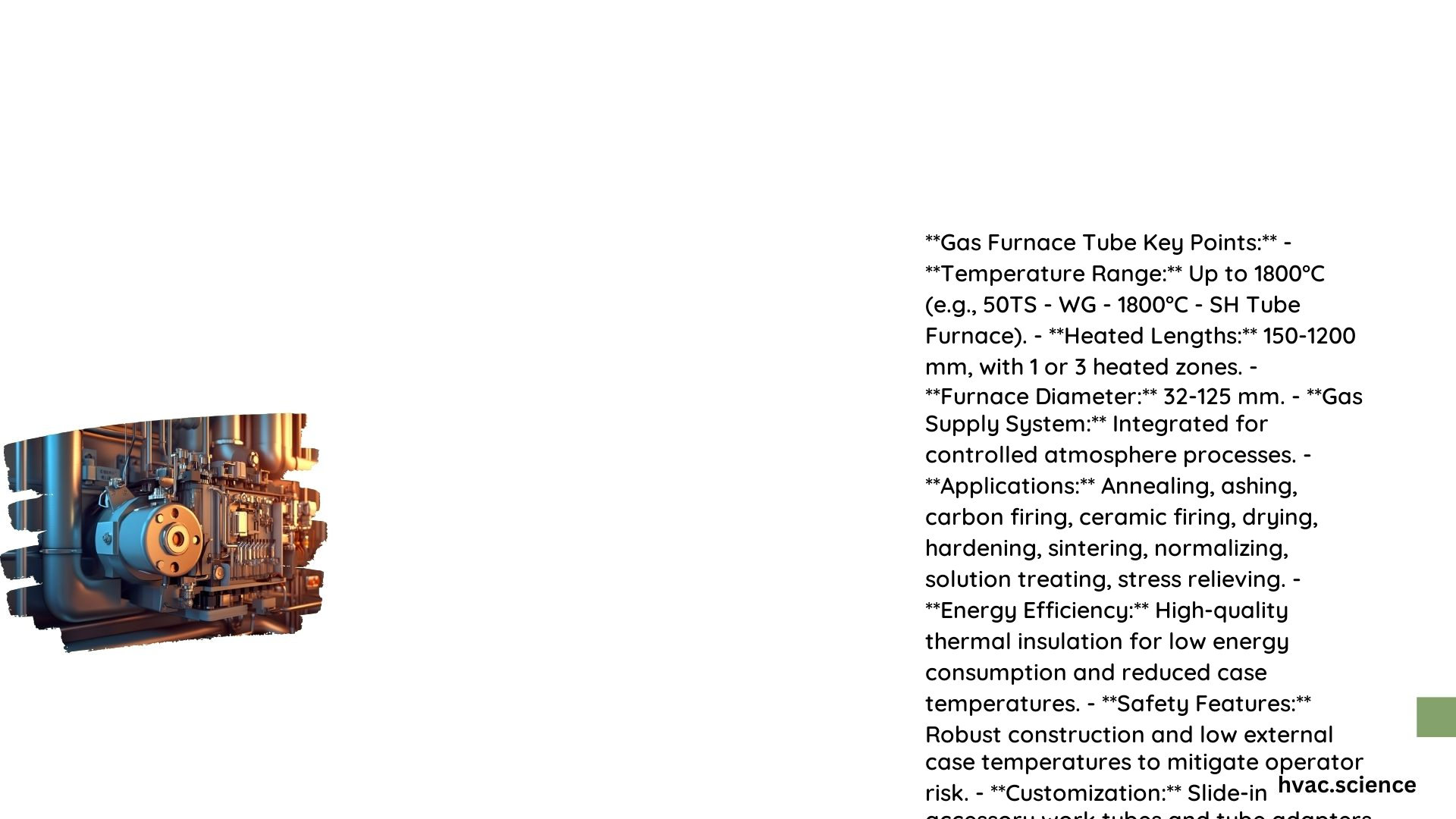The term “Gas Furnace Tube” typically refers to the components within a tube furnace that are used for various high-temperature processes, often involving gases. This comprehensive blog post will delve into the construction, materials, dimensions, and specifications of tube furnaces, as well as explore the operational mechanisms of natural and induced draft furnaces.
What is the Construction and Materials Used in Gas Furnace Tubes?
What are the Key Components of Tube Furnace Construction?
Tube furnaces are designed with the following key components:
- Heating Elements: High-quality heating elements such as APM (Advanced Precious Metal) wire or similar materials are commonly used. These elements are mounted within ceramic fiber insulation to ensure efficient heat distribution.
- Insulation: Ceramic fiber modules are used to insulate the heating elements, ensuring minimal heat loss and maintaining the desired temperature within the furnace.
- Housing: The outer casing is typically made of durable materials such as stainless steel or other heat-resistant metals. Cooling channels may be integrated to aid in convection cooling of the outer case.
What Materials are Used in Gas Furnace Tubes?
The materials used in gas furnace tubes include:
- Work Tubes: These can be made from various materials such as quartz, alumina, or other refractory materials, depending on the specific application and required temperature tolerance.
- Heating Elements: As mentioned, APM wire or similar high-temperature resistant materials are used.
What are the Dimensions and Specifications of Gas Furnace Tubes?

What are the Typical Heated Length and Diameter Ranges of Tube Furnaces?
Tube furnaces come in various heated lengths and diameters, such as:
- The TF range by Carbolite Gero offers heated lengths from 150 mm to 1200 mm and diameters from 32 mm to 125 mm.
- The PTF series by Protherm Furnaces also offers a range of heated lengths and diameters, with maximum temperatures up to 1800°C.
What are the Operational Temperature Ranges of Tube Furnaces?
The maximum operating temperatures of tube furnaces can range from 1100°C to 1800°C, depending on the model and application.
What are the Main Types of Tube Furnaces?
What are the Differences Between Single Zone and Multi-Zone Furnaces?
Tube furnaces can be classified into two main types:
- Single Zone Furnaces: These have a single heated zone and are suitable for processes requiring a uniform temperature profile.
- Multi-Zone Furnaces: These have multiple heated zones, allowing for more complex temperature profiles and better control over the heating process.
How Do Tube Furnaces Operate in Horizontal and Vertical Orientations?
Many tube furnaces can be used either horizontally or vertically, offering flexibility in laboratory settings. Some tube furnaces are also equipped with gas supply systems, allowing for operation under vacuum or modified atmospheres.
How Does a Natural Draft Furnace Operate with a Gas Furnace Tube?
In a natural draft furnace, the Gas Furnace Tube is part of the overall furnace design, ensuring that the combustion process occurs efficiently within the tube. The tube is heated by the combustion process, and the natural draft helps maintain the temperature and ensure proper gas flow.
How Does an Induced Draft Furnace Improve Efficiency with a Gas Furnace Tube?
Induced draft furnaces use a fan or blower to create a negative pressure, drawing combustion air into the furnace and expelling exhaust gases. This mechanism enhances efficiency compared to natural draft furnaces.
How is the Efficiency of an Induced Draft Furnace Calculated?
The efficiency of an induced draft furnace can be calculated using the formula:
( \text{Efficiency} = \frac{\text{Heat Output}}{\text{Heat Input}} \times 100\% )
Induced draft furnaces typically have higher efficiencies due to better control over airflow and combustion conditions.
What are the Key Performance Metrics for an Induced Draft Furnace with a Gas Furnace Tube?
The key performance metrics include:
- Pressure Ratings: The pressure rating of the furnace and associated components, such as the Gas Furnace Tube, must be compatible with the induced draft system to ensure safe and efficient operation.
- Temperature Tolerances: The materials used in the Gas Furnace Tube must be able to withstand the high temperatures and any thermal stresses induced by the draft system.
What are the Installation Requirements for a Gas Furnace Tube in an Induced Draft Furnace?
Proper installation of the Gas Furnace Tube and associated components is crucial to ensure safe and efficient operation. This includes ensuring that all connections are secure, and the system is properly sealed to maintain the desired atmosphere.
What are the HVAC Technical Specifications for a Gas Furnace Tube?
What are the Typical Pressure Ratings for a Gas Furnace Tube?
The pressure rating of the Gas Furnace Tube and associated components should be compatible with the operating pressures of the furnace, typically in the range of a few millibars to several bars, depending on the application.
What are the Temperature Tolerances for a Gas Furnace Tube?
The materials used in the Gas Furnace Tube must be able to withstand the maximum operating temperatures of the furnace, which can range from 1100°C to 1800°C.
What are the Installation Requirements for a Gas Furnace Tube?
The furnace should be installed in a well-ventilated area, and all electrical connections must be made according to the manufacturer’s specifications to ensure safe operation.
References
- Carbolite Gero – Split Tube Furnaces:
- FST/FZS Split Tube Furnaces.
- Carbolite Gero – TF Tube Furnace Range:
- TF Tube Furnace Range.
- Protherm Furnaces – PTF Series:
- PTF Series Tube Furnaces.
